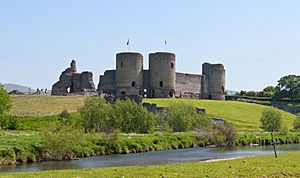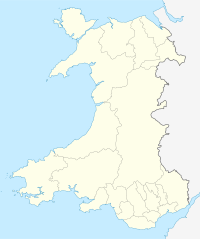Rhuddlan Castle facts for kids
Quick facts for kids Rhuddlan Castle |
|
|---|---|
| Castell Rhuddlan | |
| Part of Denbighshire | |
| Rhuddlan, Wales | |

A view of the castle from across the River Clwyd.
|
|
| Coordinates | 53°17′20″N 3°27′52″W / 53.2889°N 3.464528°W |
| Type | Concentric castle |
| Site information | |
| Controlled by | Cadw |
| Condition | Ruin |
| Site history | |
| Built | From 1277 to 1282 |
| Built by | Master Bertram James of St. George |
| In use | Open to public. |
| Materials | Limestone |
| Demolished | 1648 |
| Events | Welsh Wars English Civil War |
|
Listed Building – Grade I
|
|
Rhuddlan Castle (Welsh: Castell Rhuddlan) is a famous castle in Rhuddlan, Denbighshire, Wales. King Edward I started building it in 1277. This was right after the First Welsh War, when England was trying to take control of Wales.
The castle was mostly designed by a skilled builder named James of Saint George. Rhuddlan Castle was finished in 1282. It was built at the same time as Flint Castle, as King Edward I worked to secure his rule over Wales. For a short time, the castle was his home. It's believed his daughter, Elizabeth, was born there.
Contents
Building Rhuddlan Castle
Rhuddlan Castle was planned as a concentric castle. This means it has walls built inside other walls, like a target. This design made it very strong and hard to attack.
Castle Design and Features
Rhuddlan Castle has a special 'diamond' shape. Its main gatehouses are at the corners of the square areas inside, not along the sides. This is different from other castles like Flint or Beaumaris. Records show that building Rhuddlan was a huge project for the English in the late 1270s.
The castle has an inner ward (the main area inside). This ward has strong defensive walls with two-tower gatehouses. Around the inner ward is an outer ward. This outer area is protected by a curtain wall with smaller towers. One tower was called "Grain Tower" and another "The King's Tower."
Water Defenses
The castle was protected on three sides by a moat (a deep ditch filled with water). The River Clwyd protected the fourth side. Inside the inner ward, there was a large hall, kitchens, private rooms, and a chapel. The outer area had a granary (for storing grain), stables, and a smithy (where metal was worked).
The castle is right next to the River Clwyd. While the castle was being built, the river was made straight and deeper. This allowed ships to sail inland directly to the castle. This was important because it meant supplies and soldiers could reach the castle even if enemies blocked the roads.
An extra protective barrier of earth and wood was added around the castle between 1280 and 1282. The castle was fully built before Llywelyn the Last started a rebellion in 1282.
Castle History
The area around Rhuddlan has a long history, even before Edward I built his castle.
Early History of Rhuddlan
Before the Normans came, Rhuddlan was an important Welsh area. The Lords of Rhuddlan ruled the lands of north-east Wales for Gruffydd ap Llywelyn. He was the last ruler of all Wales. The town itself started as a Saxon "burgh" (a fortified town) built by Edward the Elder.
In the late 1000s, the Normans invaded Wales. Rhuddlan was a key location, so it was often fought over. The Welsh Princes of Gwynedd and the Earls of Chester battled for control. Gruffydd ap Llywelyn even took the town back from Harold Godwinson. You can still see the remains of a Norman castle at Twthill, built in 1086. This earlier castle was built by Robert of Rhuddlan, who supported King William I.
Edward I's Conquest
In July 1277, when the Welsh Wars began, Edward I started building Flint Castle. With help from 25 ships from the Cinque Ports (a group of English coastal towns), his army moved along the coast. By August, Edward's forces reached Rhuddlan. He could easily get supplies by river, which was very helpful. Three months later, the town became part of the English Crown. This happened after the Treaty of Aberconwy was signed between Llywelyn ap Gruffudd and Edward I.
Work on Rhuddlan Castle began right away. Master Bertram, an engineer from Gascony, started the project. But soon, a master builder from Savoy named James of St George took over. He was in charge until 1282. The Welsh attacked the castle during the 1282 rebellion, but an English force came to help.
Edward I also created a new town, or "borough," north of his castle. This new town was separate from the older Norman town. The streets of this 13th-century town can still be seen today. Like at Flint, the new town was protected by ditches and a wooden fence. Rhuddlan Castle became part of Edward's "Ring of Iron" – a group of strong castles built to control Wales.
Key Events at the Castle
Elizabeth, King Edward I's eighth daughter, was born at Rhuddlan in 1282. This was the same year the castle was finished. Two years later, an important document called the Statute of Rhuddlan was signed at the castle. This happened after Llewellyn the Last was defeated. The Statute gave all the lands of the Welsh Princes to the English Crown. It also brought English common law to Wales. This meant Edward I could appoint officials like sheriffs and constables to collect taxes and enforce English law.
Even though English law was introduced, Welsh law continued to be used locally for a long time. This changed in 1536 when new laws made English common law the only legal system in Wales.
Later Conflicts and Decline
In 1294, the castle was attacked during a Welsh uprising led by Madog ap Llywelyn. However, the castle was not captured. It stayed in English hands. In 1399, King Richard II of England stopped at Rhuddlan on his way to Flint, where he was taken prisoner by Henry IV.
The castle was attacked again in 1400 by forces of Owain Glyndŵr. The town was badly damaged, but the castle held strong. In the late 1400s and early 1500s, the castle became less important. Its condition started to get worse.
During the English Civil War, Rhuddlan Castle was held by Royalist troops who supported King Charles I of England. It remained a Royalist stronghold even after the Battle of Naseby. But in 1646, Parliamentary forces led by Thomas Mytton took the castle after a siege. Two years later, Parliamentarians partly destroyed the castle. They did this to stop it from being used for military purposes again. By 1781, the castle was mostly in ruins.
Present Day
Today, Rhuddlan Castle is looked after by Cadw. This is a Welsh-government body that works to protect, save, and promote Wales's historic buildings.
Images for kids
See also
 In Spanish: Castillo de Rhuddlan para niños
In Spanish: Castillo de Rhuddlan para niños




